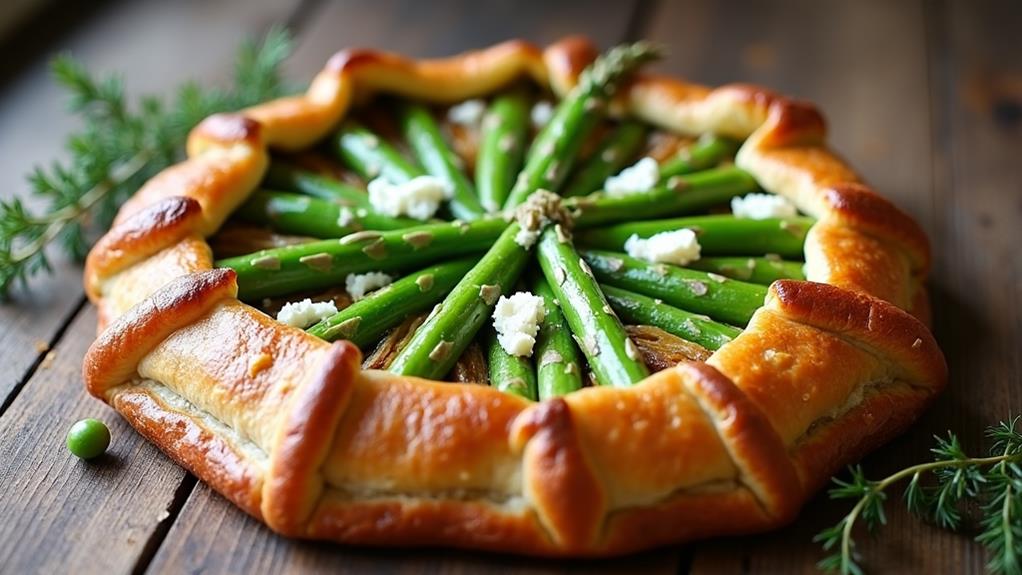When you bite into a Spring Vegetable Feta and Miso-Sesame Galette, you're experiencing a fusion of French rustic charm and Asian-inspired flavors. This unique dish combines the flaky pastry of a traditional galette with the fresh crunch of spring vegetables and the umami depth of miso. It's a versatile creation that can grace your table as an elegant appetizer or take center stage as a main course. But there's more to this galette than meets the eye. Its intriguing combination of ingredients and cultural influences raises questions about the evolution of modern cuisine and the art of balancing diverse flavors.
Key Takeaways
- Combines a flaky pastry crust with spring vegetables, feta cheese, and a miso-sesame dressing.
- Features a customizable filling using seasonal produce like asparagus, peas, and leeks.
- Bakes at 375°F (190°C) for 35-40 minutes until the crust is golden brown and vegetables are tender.
- Offers a rustic, adaptable dish suitable for various occasions, from brunches to appetizers.
- Incorporates French culinary tradition with modern flavors for a unique and delicious savory tart.
History
The spring vegetable galette traces its roots back to rustic French cuisine. You'll find its origins in the traditional "galette," a term that refers to various types of flat, round cakes or pastries. Historically, galettes were made with buckwheat flour in Brittany, France, and often served as a savory meal for farmers and laborers.
Over time, the concept evolved, and bakers began experimenting with different fillings, including seasonal vegetables. As culinary traditions spread and merged, the spring vegetable galette gained popularity beyond France.
You'll notice that modern versions often incorporate influences from various cuisines, such as the addition of feta cheese or miso-sesame flavors. This fusion approach has transformed the humble galette into a versatile dish that celebrates seasonal produce.
Today, you can find countless variations of spring vegetable galettes in bakeries, cafes, and home kitchens around the world. The dish's adaptability and rustic charm have ensured its place in contemporary cuisine, allowing you to enjoy a taste of French culinary history with a modern twist.
Recipe
A spring vegetable galette is a delightful and versatile dish that celebrates the fresh flavors of the season. This rustic, free-form tart combines a flaky pastry crust with a medley of spring vegetables, creating a beautiful and delicious centerpiece for any meal.
This recipe features a combination of asparagus, peas, and leeks, but feel free to experiment with other spring vegetables you have on hand. The galette's simplicity allows the natural flavors of the vegetables to shine, while a touch of goat cheese adds a creamy, tangy element that complements the vegetables perfectly.
Ingredients:
- 1 1/4 cups (156g) all-purpose flour
- 1/4 teaspoon salt
- 8 tablespoons (113g) cold unsalted butter, cubed
- 3-4 tablespoons ice water
- 1 bunch asparagus, trimmed and cut into 2-inch pieces
- 1 cup (150g) fresh or frozen peas
- 1 leek, white and light green parts only, thinly sliced
- 2 tablespoons olive oil
- 1 teaspoon fresh thyme leaves
- Salt and pepper to taste
- 4 oz (113g) goat cheese, crumbled
- 1 egg, beaten (for egg wash)
To prepare the galette, start by making the pastry dough. Combine the flour and salt in a food processor, then add the cold butter and pulse until the mixture resembles coarse crumbs. Gradually add ice water, pulsing until the dough comes together.
Form the dough into a disk, wrap in plastic, and refrigerate for at least 1 hour. While the dough chills, sauté the vegetables in olive oil until tender-crisp, then let them cool.
Roll out the chilled dough on a floured surface into a 12-inch circle, transfer to a baking sheet, and spread the vegetable mixture in the center, leaving a 2-inch border. Sprinkle with goat cheese, fold the edges of the dough over the filling, brush with egg wash, and bake at 375°F (190°C) for 35-40 minutes until golden brown.
For best results, make sure your butter and water are very cold when preparing the pastry dough. This helps create a flakier crust. Don't overmix the dough, as this can lead to a tough galette.
If you're short on time, you can use store-bought pie crust instead of making your own. Feel free to customize the filling with your favorite spring vegetables or herbs, and experiment with different types of cheese for varied flavors.
Cooking Steps
To create your spring vegetable galette, you'll follow a series of essential steps that transform simple ingredients into a stunning dish.
You'll begin by preparing and chilling the dough, then move on to crafting a flavorful vegetable filling mixture.
The process culminates in assembling the galette on parchment paper, baking it to golden perfection, and finally garnishing with fresh herbs for a burst of color and flavor.
Step 1. Prepare Dough and Chill
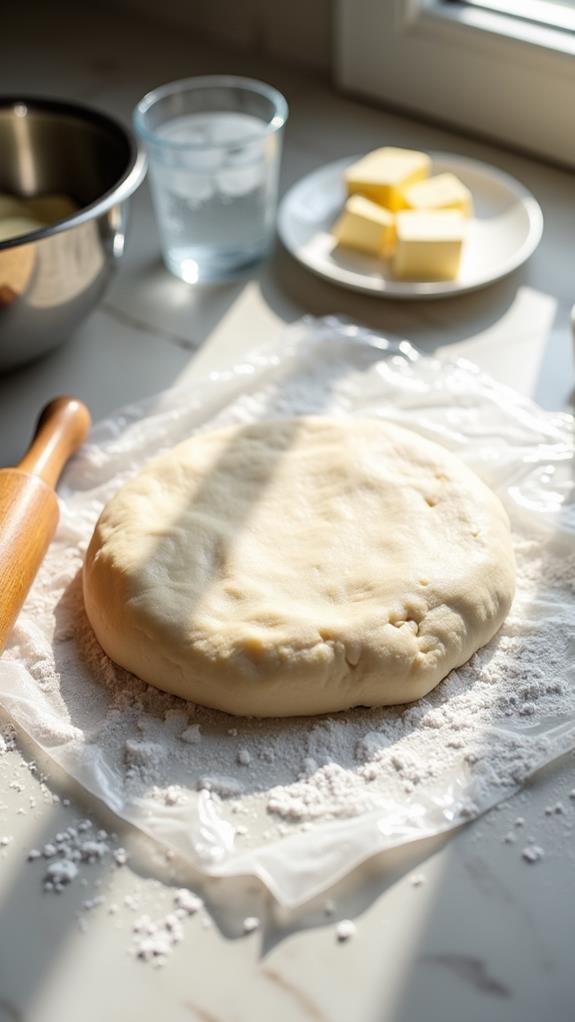
Begin by mixing together flour, salt, and sugar in a large bowl. Add cold, cubed butter and use your fingertips to work it into the dry ingredients until the mixture resembles coarse crumbs.
Gradually pour in ice-cold water, stirring with a fork until the dough just comes together. Don't overwork it; you want visible bits of butter for a flaky crust.
Turn the dough out onto a lightly floured surface and shape it into a disk. Wrap it tightly in plastic wrap and refrigerate for at least an hour, or up to overnight.
This chilling period is crucial, as it allows the gluten to relax and the butter to firm up, resulting in a more tender and flaky crust.
When you're ready to use the dough, remove it from the refrigerator and let it sit at room temperature for about 10 minutes.
This brief rest will make it easier to roll out without cracking. Remember, a well-chilled and rested dough is the foundation of a perfect galette, so don't rush this step.
Step 2. Prepare Vegetable Filling Mixture
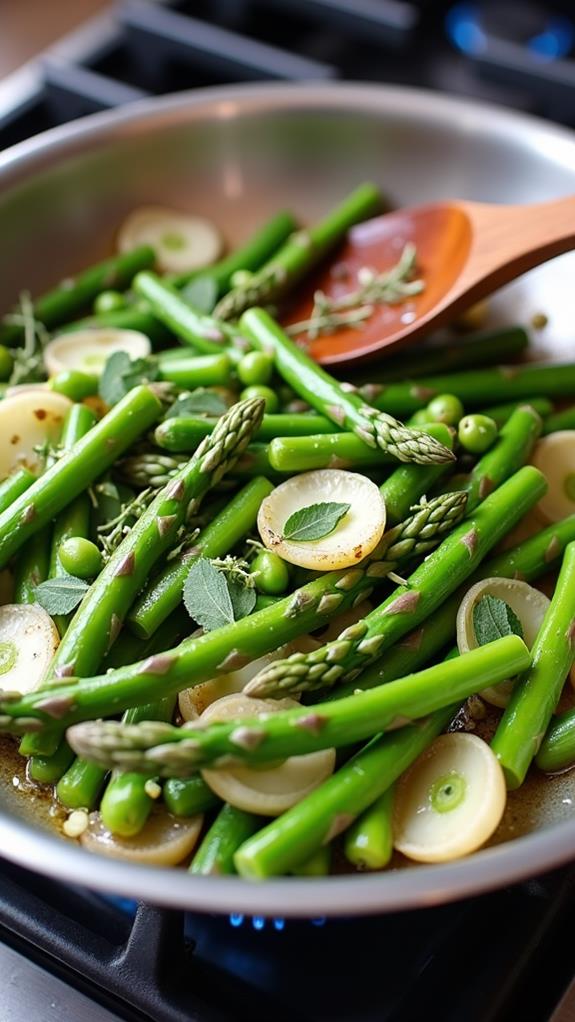
While the dough chills, you'll prepare the vibrant spring vegetable filling. Start by washing and trimming your chosen spring vegetables, such as asparagus, peas, and radishes. Slice the asparagus into 1-inch pieces and halve the radishes. In a large bowl, combine the prepared vegetables with minced garlic, chopped fresh herbs like dill and parsley, and crumbled feta cheese.
In a separate small bowl, whisk together white miso paste, sesame oil, rice vinegar, and a touch of honey to create a flavorful dressing. Pour this mixture over the vegetables and gently toss to coat everything evenly. The miso-sesame dressing will add depth and umami to your galette filling.
Season the mixture with salt and freshly ground black pepper to taste, being mindful that the feta cheese already contributes saltiness. Let the filling sit for about 10 minutes to allow the flavors to meld. This resting period also helps the vegetables slightly soften, ensuring they'll cook perfectly in the galette.
Your spring vegetable filling is now ready to be showcased in your rustic tart.
Step 3. Assemble Galette on Parchment
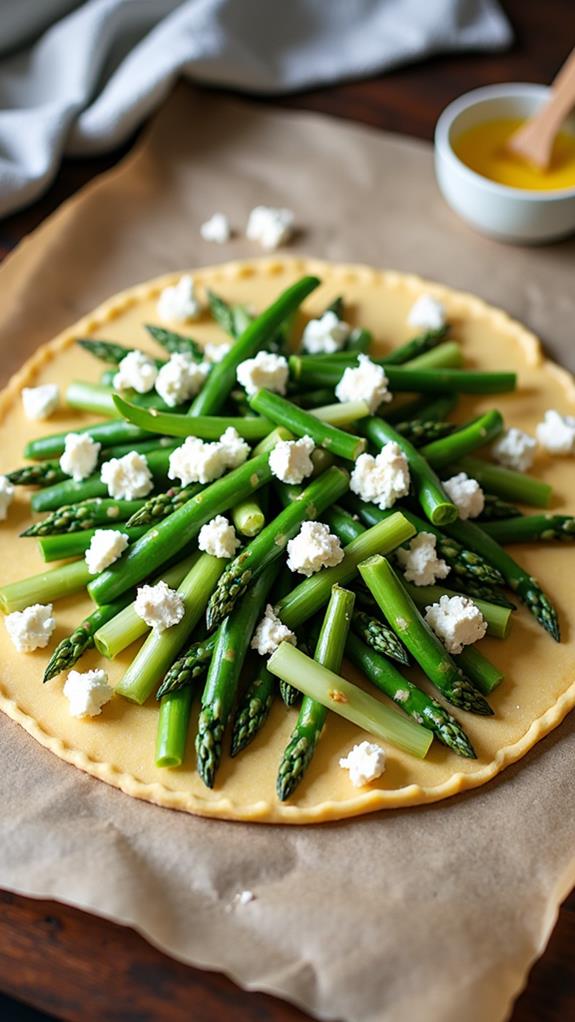
The assembly of your galette marks an exciting step in the cooking process.
Begin by preheating your oven to 400°F (200°C) and lining a baking sheet with parchment paper. Carefully transfer your rolled-out dough onto the prepared sheet, ensuring it's centered and flat.
Next, spread a thin layer of the miso-sesame mixture over the dough, leaving a 2-inch border around the edges. This flavorful base will complement the vegetables beautifully.
Arrange your prepared vegetable filling in an even layer over the miso-sesame spread, maintaining the border. You'll want to create a visually appealing pattern with the various vegetables, showcasing their vibrant colors.
Once you're satisfied with the arrangement, it's time to form the galette's signature shape. Gently fold the edges of the dough over the filling, pleating as you go. This rustic fold will contain the filling and create a charming, free-form tart.
Step 4. Bake Galette Until Golden
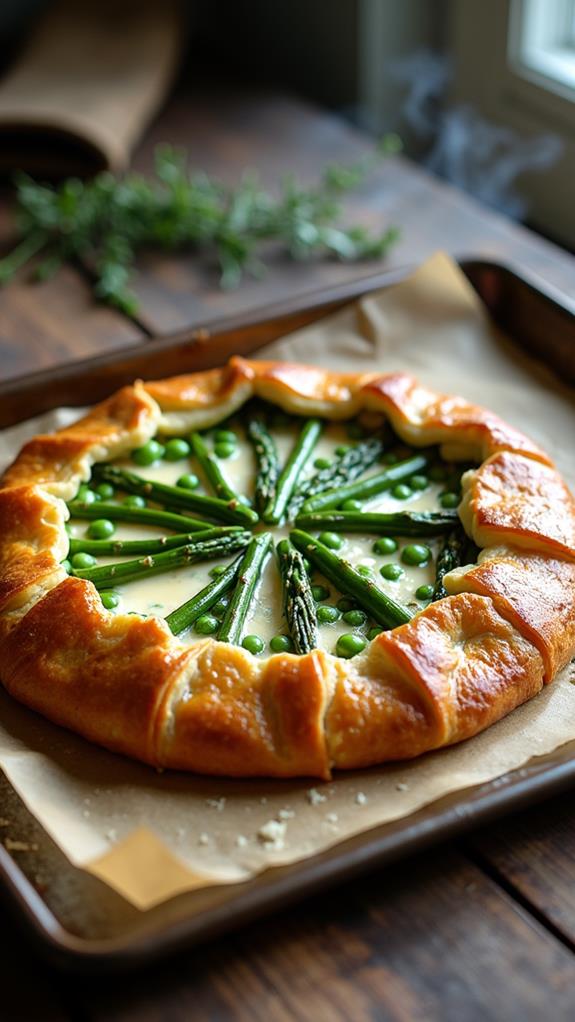
After assembling your galette, it's time to bake it to golden perfection. Preheat your oven to 400°F (200°C) and position a rack in the center. Carefully transfer the parchment paper with your assembled galette onto a baking sheet. This will make it easier to slide the galette into the oven without disturbing its shape.
Before baking, brush the exposed pastry edges with an egg wash made from one beaten egg mixed with a tablespoon of water. This will give your galette a beautiful golden sheen. For added texture and flavor, you can sprinkle the crust with coarse sea salt or sesame seeds.
Place the baking sheet with your galette in the preheated oven and bake for 30-35 minutes. You'll know it's done when the crust is golden brown and the vegetables are tender. If the edges start to brown too quickly, cover them loosely with aluminum foil.
Once baked, remove the galette from the oven and let it cool on the baking sheet for 5-10 minutes. This will allow the filling to set slightly, making it easier to slice and serve.
Step 5. Garnish With Fresh Herbs
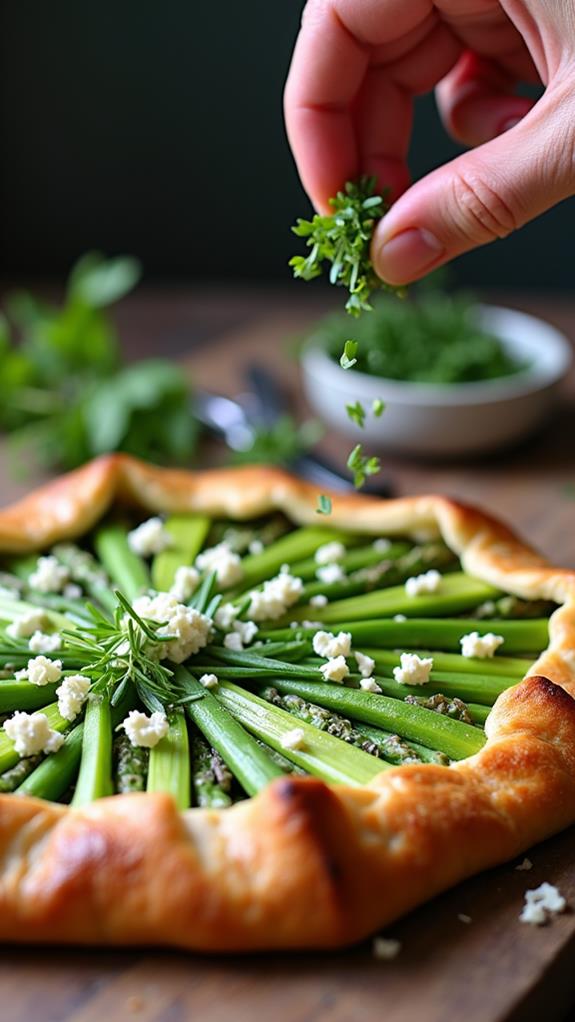
Now that your galette is baked to perfection, it's time to add the finishing touch: fresh herbs. Select a variety of herbs that complement the spring vegetables in your galette. Basil, chives, parsley, and thyme are excellent choices that'll bring brightness and depth to the dish.
Before garnishing, allow the galette to cool for about 5 minutes, ensuring the herbs won't wilt immediately upon contact.
Gently tear or chop the herbs into small pieces, depending on your preference and the herb's texture. Sprinkle them evenly over the surface of the galette, focusing on the exposed vegetable filling.
Don't be shy with the herbs; their vibrant colors and fresh aromas will enhance the visual appeal and flavor profile of your creation. For an extra touch of elegance, consider adding a few whole herb leaves as a centerpiece.
Final Thoughts
Countless variations of this spring vegetable galette can be created to suit your taste and seasonal produce availability. You can experiment with different vegetables, cheeses, or even incorporate proteins like prosciutto or smoked salmon.
Don't hesitate to adjust the seasoning blend to complement your chosen ingredients. Remember, the key to a successful galette lies in achieving a balance of flavors and textures.
As you become more comfortable with the recipe, you'll find that this versatile dish can be adapted for various occasions. It's perfect for brunches, light dinners, or as an impressive appetizer for gatherings.
The rustic appearance of the galette adds charm to any table setting, while its delicious flavors will keep your guests coming back for more.
When storing leftovers, wrap the galette tightly in plastic wrap or aluminum foil and refrigerate for up to three days.
To reheat, place it in a preheated oven at 350°F (175°C) for about 10 minutes, or until warmed through. This will help maintain the crispy texture of the crust.

